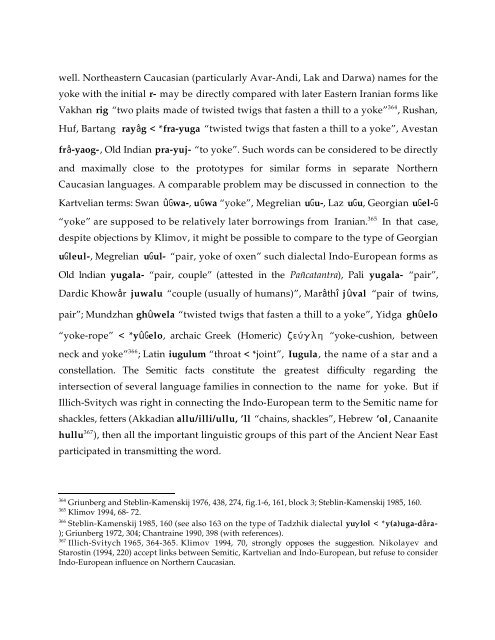Comparative Notes on Hurro-Urartian, Northern Caucasian
Comparative Notes on Hurro-Urartian, Northern Caucasian
Comparative Notes on Hurro-Urartian, Northern Caucasian
You also want an ePaper? Increase the reach of your titles
YUMPU automatically turns print PDFs into web optimized ePapers that Google loves.
well. Northeastern <strong>Caucasian</strong> (particularly Avar-Andi, Lak and Darwa) names for the<br />
yoke with the initial r- may be directly compared with later Eastern Iranian forms like<br />
Vakhan rig “two plaits made of twisted twigs that fasten a thill to a yoke” 364 , Rushan,<br />
Huf, Bartang rayâg < *fra-yuga “twisted twigs that fasten a thill to a yoke”, Avestan<br />
frâ-yaog-, Old Indian pra-yuj- “to yoke”. Such words can be c<strong>on</strong>sidered to be directly<br />
and maximally close to the prototypes for similar forms in separate <strong>Northern</strong><br />
<strong>Caucasian</strong> languages. A comparable problem may be discussed in c<strong>on</strong>necti<strong>on</strong> to the<br />
Kartvelian terms: Swan ûGwa-, uGwa “yoke”, Megrelian uGu-, Laz uGu, Georgian uGel-G<br />
“yoke” are supposed to be relatively later borrowings from Iranian. 365 In that case,<br />
despite objecti<strong>on</strong>s by Klimov, it might be possible to compare to the type of Georgian<br />
uGleul-, Megrelian uGul- “pair, yoke of oxen” such dialectal Indo-European forms as<br />
Old lndian yugala- “pair, couple” (attested in the Pañcatantra), Pali yugala- “pair”,<br />
Dardic Khowâr juwalu “couple (usually of humans)”, Marâthî jûval “pair of twins,<br />
pair”; Mundzhan ghûwela “twisted twigs that fasten a thill to a yoke”, Yidga ghûelo<br />
“yoke-rope” < *yûGelo, archaic Greek (Homeric) zeÊglh “yoke-cushi<strong>on</strong>, between<br />
neck and yoke” 366 ; Latin iugulum “throat < *joint”, Iugula, the name of a star and a<br />
c<strong>on</strong>stellati<strong>on</strong>. The Semitic facts c<strong>on</strong>stitute the greatest difficulty regarding the<br />
intersecti<strong>on</strong> of several language families in c<strong>on</strong>necti<strong>on</strong> to the name for yoke. But if<br />
Illich-Svitych was right in c<strong>on</strong>necting the Indo-European term to the Semitic name for<br />
shackles, fetters (Akkadian allu/illi/ullu, ’ll “chains, shackles”, Hebrew ’ol, Canaanite<br />
hullu 367 ), then all the important linguistic groups of this part of the Ancient Near East<br />
participated in transmitting the word.<br />
364 Griunberg and Steblin-Kamenskij 1976, 438, 274, fig.1-6, 161, block 3; Steblin-Kamenskij 1985, 160.<br />
365 Klimov 1994, 68- 72.<br />
366 Steblin-Kamenskij 1985, 160 (see also 163 <strong>on</strong> the type of Tadzhik dialectal yuglol < *y(a)uga-dâra-<br />
); Griunberg 1972, 304; Chantraine 1990, 398 (with references).<br />
367 Illich-Svitych 1965, 364-365. Klimov 1994, 70, str<strong>on</strong>gly opposes the suggesti<strong>on</strong>. Nikolayev and<br />
Starostin (1994, 220) accept links between Semitic, Kartvelian and Indo-European, but refuse to c<strong>on</strong>sider<br />
Indo-European influence <strong>on</strong> <strong>Northern</strong> <strong>Caucasian</strong>.





